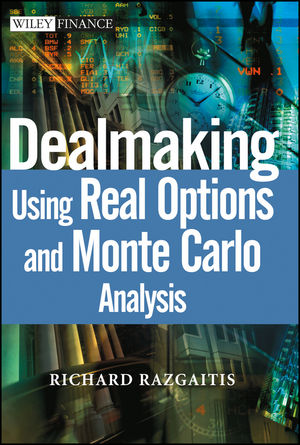Dealmaking: Using Real Options and Monte Carlo AnalysisISBN: 978-0-471-25048-7
Hardcover
312 pages
August 2003
 This is a Print-on-Demand title. It will be printed specifically to fill your order. Please allow an additional 10-15 days delivery time. The book is not returnable.
|
||||||
Why Another Negotiating Book?
iDealmaking™.
High Significance, High Ambiguity Contexts.
The “So What?” Question.
Valuation, Pricing, and Negotiation.
Tangible and Intangible Content/Value and the New Economy.
The iDealmaking Process.
Organization of the Book.
CHAPTER 2: Negotiation People, Language, and Frameworks.
Negotiation People.
A Quest.
The Nut, the Number, the Bogie, and the Toe Tag.
Quantification, Rationality, and Hyperrationality.
CHAPTER 3: The Box and the Wheelbarrow: What Am I Selling (or Buying)?
The Box.
The Wheelbarrow.
iDealmaking’s Spine.
The Term Sheet.
Methods and Tools.
CHAPTER 4: Discounted Cash Flow Analysis and Introduction to Monte Carlo Modeling.
Discounted Cash Flow Analysis.
Scenario (DCF) Analysis.
Monte Carlo Method: An Introduction.
Closure and Application to Negotiation.
CHAPTER 5: Monte Carlo Method.
A Model Cash Flow Template.
Income and Cash Flow Statements: 3M Example.
Monte Carlo Assumption Tools.
Uniform Distribution: Highest Uncertainty Between Certain Bounds.
Triangular Distribution.
The Normal Distribution.
Other Distribution Functions.
Monte Carlo Model of the DCF Template.
Combined CAGR and Cost Ratio Uncertainty Distributions.
Correlating Assumptions.
Additional Assumption Distributions.
Twentieth (and Other) Percentile Valuations.
Comparison of Monte Carlo Results with DCF (RAHR) Method.
Scenario Modeling in Monte Carlo.
Monte Carlo Tools for Determining Variable Significance.
Final Points on the Monte Carlo Model.
Appendix 5A: Crystal Ball Report Corresponding to the Results Presented in Exhibit 5.15 for a Uniform Cost Distribution Assumption.
Appendix 5B: Crystal Ball Report Corresponding to the Results Presented in Exhibit 5.16 for a Double-Humped Cost Distribution Assumption.
CHAPTER 6: Introduction to Real Options.
Perspective 1: Discounted Cash Flow (DCF) View of the Six-Scenario Opportunity.
Perspective 2: Real Option View of the Six-Scenario Opportunity.
Perspective 3: A Model for a Buyer’s Counteroffer.
Black-Scholes Equation for Option Pricing.
The Black-Scholes Equation Applied to an Option to a Share of Yahoo!
What Do Equations Represent? “What Is Truth?”.
Using Black-Scholes for an Opportunity Valuation .
Summary of Real Option Realities versus Black-Scholes.
CHAPTER 7: Real Options Applied to Dealmaking.
Beyond Black-Scholes.
Emergence of Real Options Analysis.
Introducing the Binomial Lattice for Real Options.
Calculating Option Values from Binomial Matrices.
Calculating Option Values Using Decisioneering’s Real Options Analysis Toolkit.
Using Real Options Analysis Toolkit Software in Dealmaking.
Calculating (or Estimating) Option Volatility.
Calculating the Option Value of Options on Options.
Conclusions and Observations.
Appendix 7A: Real Options Equations.
CHAPTER 8: Knowledge and Unertainty.
Future Knowledge.
Dealing with Uncertainty.
Standards.
What About Truth?
CHAPTER 9: Deal Pricing.
Simple Pricing.
Box Pricing.
Wheelbarrow Pricing.
Total Cash Payment.
Cash When.
Cash Maybe.
Cash As.
Cash Substitutes.
Term Sheets.
CHAPTER 10: Negotiation Perspectives and Dynamics.
Negotiation Perspectives.
Negotiating Sequencing.
Issue Explosion.
Negotiating Values.
Deal/Agreement Complexity.
CHAPTER 11: Plan B.
Auctions and Betrothals.
Plan B Analysis and Tools.
Plan B Implementation.
Plan B Caution.
Plan B from the Buyer’s Perspective.
Plan B and Life.
CHAPTER 12: Conclusion.
In Theory, In Practice.
Value Creation by Dealmaking.
A Final (True) Story.
Bibliography.
Index.



